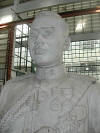|
Phibun Songkram (พิบูล สงคราม)
Field Marshall and Prime Minister during WW II. During the interregnum of
Rama VII and
Rama VIII the
Kingdom of
Siam
was governed by a governing council and frequently lived in the grip of military despots, including Phibun Songkram. The latter found inspiration with leaders like Mussolini and Hitler, and while he ruled the people with an iron fist he changed the name in 1939 from Siam into Prathet Thai
(ประเทศไทย),
i.e.
‘Thailand’,
which translates as
‘Land of the
Free’. In 1944 he was forced to step down after he sided with Japan during WW II. For a while it seemed a democratic civilian regime would be installed but due to the confusion following the mysterious death of Rama VIII, the military once again seized power in a coup d'état. In 1948,
Phibun
made a political comeback, but his popularity had faded and in 1957 he was ousted in yet another coup d'état. To date,
Phibun Songkram
is the longest serving Prime Minister in Thai history.
Beautifully located on a hill overlooking the city of
Chiang Rai
is the
Phibun Songkram Military
Museum, also known as the Phibun Songkram House, the Field
Marshall Plaek Phibun Songkram (แปลก พิบูลสงคราม) Museum,
the Army Museum and the Military Museum, and in Thai as
Phiphithaphan Thahaan
Monthon
Thahaan Thih 37
(พิพิธภัณฑ์ทหาร มณฑลทหารบกที่
37), i.e.
‘Military
Museum of the 37th Army District’.
The half-timbered house, with its structural timbers exposed
for decoration, gives the building a colonial look. It was
constructed in the years 1940-41 for the Field Marshall who
was then Prime Minister of Thailand in his first term. The
museum exhibits items related to the life of the Field
Marshall and to the
May 1942
invasion of
the Siamese Shan States of
Burma,
i.e. present-day
Shan
State in
Myanmar,
during World War II.
The Thai Phayap Army,
referred to in Thai as
Kong Thap
Phayap
(กองทัพพายัพ) and meaning the
‘Northwestern
Army’,
occupied these territories, known as Saharat Thai Deum (สหรัฐไทยเดิม),
i.e. the
‘Unified
Former Thai Territories’,
as an administrative division of Thailand, until the end of
World War II. The museum has a bust and several photos of
the man and in the garden is a life-sized figure of him in
his military uniform.
WATCH VIDEO
and
MORE ON THIS.
回






|

